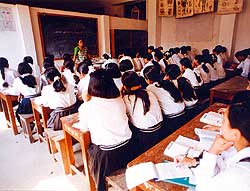 This week nearly 300,000 students are sitting for their School Leaving Certificate examinations all over the country. Despite the introduction of the 10+2 system, SLC continues to retain its mystic importance as the gate to future career options. Students (and, even more, their parents) regard the exams with a mixture of hope and trepidation.
This week nearly 300,000 students are sitting for their School Leaving Certificate examinations all over the country. Despite the introduction of the 10+2 system, SLC continues to retain its mystic importance as the gate to future career options. Students (and, even more, their parents) regard the exams with a mixture of hope and trepidation.
For most of the 300,000, their worst fears will come true. No more than one-third of students ever pass the SLC exams. The Board of SLC Examinations cruelly declares that the rest have 'failed'. The government slams the door on these young Nepalis, stigmatising them for life as failures. While a few do doggedly return to examination halls the following year, most end up in the job market with 'SLC-appeared-but-failed' attached to their cvs.
Not all successful candidates pursue higher studies even after passing out of school. Forced by circumstance, they begin to look for jobs and realise belatedly that they possess very few marketable skills. Apart from the 3Rs (Reading, Writing, Arithmetic) of basic education, the SLC syllabus doesn't have very much to equip students for life. This certificate, as numerous parents soon discover, makes their children too good for subsistence agriculture in the village, but not quite good enough for the secondary sector of the national economy.
Like in most other prismatic societies where traditional ties and modern aspirations co-exist, nepotism and the afno manchhe culture dominates the Nepali job market. But the absence of trade education in the school curriculum is no less of a factor in flooding the offices of prospective employers with an army of virtually unemployable youths. Frustration sets in early.
Predictably, the fate of the SLC-failed is even worse than those who remain with their traditional occupations. Barring the lucky few who have connections in the right places, most of the youngsters continue to live off their parents as long as they can't find a way to escape to menial jobs in the Gulf, Malaysia or India.
Education reform should be high priority. But a bare mention of 'trade education' in schools raises the hackles of a Nepali middle-class fixated on clerk-factories. For years, the sole purpose of school has been to produce loyal servants for the regime and the state. It can be unsettling to dismantle this structure overnight.
One of the ways of making school graduates more employable is to train them for various occupations. A trained nurse, plumber, electrician, mechanic or accountant has a better chance of finding work here or getting higher pay abroad. All such skills require the ability to play with words and numbers. These are the subjects that the middle-class doesn't resent.
For the SLC-failed unwilling to pursue formal education, trade education can be an alternative option. Better trained masons, metalworkers, fitters, tailors, shoemakers, hairdressers and waiters are sure to find that an expanding service economy can never have enough of them.
Secondary education reform needs to be a part of the post-insurgency reform agenda. Whether armed cadre of the Maoists are accommodated in any of the existing forces of the government or a new outfit built to make space for them, the fact remains that most don't have skills other than pulling the trigger. It bears reckoning that many of them are also victims of a faulty school system, and should be given another chance at being trained in economically useful skills.
There was talk of polytechnics of technical education being established in every development region with Indian assistance. Such institutions for producing mid-level technical personnel have their uses. But more urgently needed are training centres that take the school-failed and transform them into successful technicians. We need to replicate the technical training centres of Jiri and Balaju.
Public-private partnership in education is a popular slogan these days. But no profit-seeking entrepreneur would be motivated to get into something that requires a relatively large initial investment, has a longer gestation period and the return is not always lucrative. Private schools and capitation-fee colleges make better financial sense. Polytechnics, trade schools and training centres producing skilled craftsmen must remain a government initiative.
Baburam Bhattarai fascinates the professional class of urban Nepal because he once topped the SLC examinations. That was before Comrade Bhattarai became an architect, and much before he became an engineer of human souls. Now that he is above ground, one wonders what he has in mind for the 'SLC-failed' who have flocked to his cause.



